Robertson, Raymond Allan
Killed in Flying Accident 1955-03-17
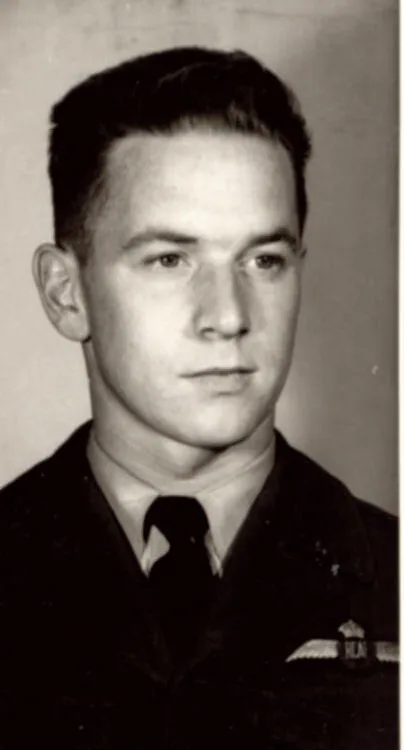

Birth Date: 1932
Born:
Son of Archibald L. and Margaret E. Robertson of Duncan, British Columbia.
Home:
Enlistment:
Enlistment Date: Unknown
Service
RCAF
Unit
430 Sqn- Squadron
Celeriter Certoque Swiftly and Surely
Base
Rank
Flying Officer
Position
Flying Officer
Service Numbers
42326
North American Sabre F-86 CAC FJ-2 FJ-3 CA-27 CL-13
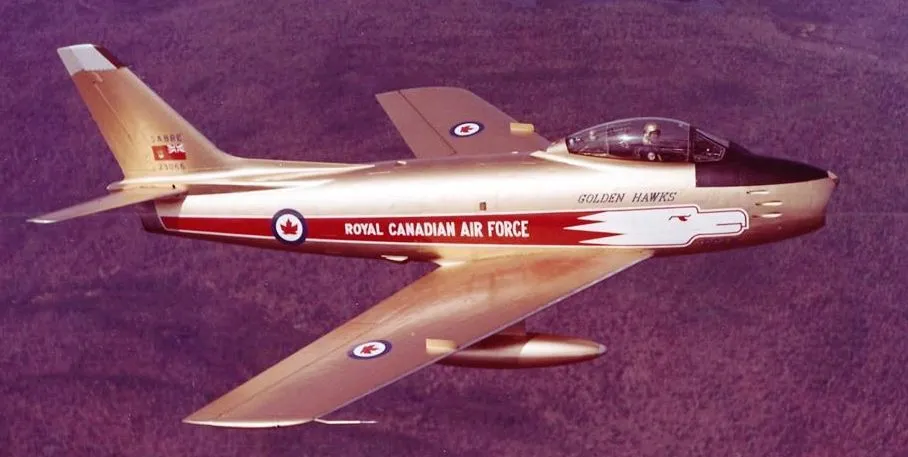
Canadair CL-13 Sabre Mk. 5 (Serial No. 23066), Golden Hawks
The North American F-86 Sabre, sometimes called the Sabrejet, is a transonic jet fighter aircraft. Produced by North American Aviation, the Sabre is best known as the United States' first swept-wing fighter that could counter the swept-wing Soviet MiG-15 in high-speed dogfights in the skies of the Korean War (1950"“1953), fighting some of the earliest jet-to-jet battles in history. Considered one of the best and most important fighter aircraft in that war, the F-86 is also rated highly in comparison with fighters of other eras. Although it was developed in the late 1940s and was outdated by the end of the 1950s, the Sabre proved versatile and adaptable and continued as a front-line fighter in numerous air forces.
Its success led to an extended production run of more than 7,800 aircraft between 1949 and 1956, in the United States, Japan, and Italy. In addition, 738 carrier-modified versions were purchased by the US Navy as FJ-2s and -3s. Variants were built in Canada and Australia. The Canadair Sabre added another 1,815 aircraft and the significantly redesigned CAC Sabre (sometimes known as the Avon Sabre or CAC CA-27), had a production run of 112. The Sabre is by far the most-produced Western jet fighter, with a total production of all variants at 9,860 units.
The fighter-bomber version (F-86H) could carry up to 2,000 lb (907 kg) of bombs, including an external fuel-type tank that could carry napalm. Unguided 2.75-inch (70-millimeter) rockets were used on some fighters on training missions, but 5-inch (127 mm) rockets were later carried on combat operations. The F-86 could also be fitted with a pair of external jettisonable jet fuel tanks (four on the F-86F beginning in 1953) that extended the range of the aircraft. Both the interceptor and fighter-bomber versions carried six 0.50 in (12.7 mm) M3 Browning machine guns with electrically-boosted feed in the nose (later versions of the F-86H carried four 20 mm (0.79 in) cannon instead of machine guns). Firing at a rate of 1,200 rounds per minute, the 0.50-inch guns were harmonized to converge at 1,000 ft (300 m) in front of the aircraft, using armor-piercing (AP) and armor-piercing incendiary (API) rounds, with one armor-piercing incendiary tracer (APIT) for every five AP or API rounds. The API rounds used during the Korean War contained magnesium, which were designed to ignite upon impact, but burned poorly above 35,000 ft (11,000 m) as oxygen levels were insufficient to sustain combustion at that height. Initial planes were fitted with the Mark 18 manual-ranging computing gun sight. The last 24 F-86A-5-Nas and F-86Es were equipped with the A-1CM gunsight-AN/APG-30 radar, which used radar to automatically compute a target's range, which later proved to be advantageous against MiG opponents over Korea.Wikipedia
 Wikipedia North American F-86 Sabre
Wikipedia North American F-86 Sabre
 YouTube F-86 Sabre Aerobatics - No Music! - Airshow London 2018
YouTube F-86 Sabre Aerobatics - No Music! - Airshow London 2018



430 Sqn Celeriter Certoque ("City of Sudbury")
h4>History of the Squadron during World War II (Aircraft: Tomahawk I, III, Mustang I, Spitfire FR Mk XIV)
[Note that the squadron crest and motto were not given to the squadron until after WWII. During WWII the squadron had neither crest nor motto.] This squadron was the third and last Army Co-operation squadron formed by the RCAF overseas in WWII. It was formed on January 1, 1943 at Hartford Bridge, Hampshire, UK and was designated Fighter Reconnaissance on June 28, 1943. The squadron carried out photographic reconnaissance for the D-Day invasion planners, and later for the air attacks on the V-1 flying bomb "No-Ball" sites. After the D-Day landings it provided tactical reconnaissance for ground forces in NW Europe. Having been formed as part of No 39 (RCAF) Wing, it joined No 11 Group of Fighter Command in June of 1943, then 2nd Tactical Air Force, No 129 (RCAF) Wing, based at Ashford, Kent and Gatwick, Surrey . It transferred to No 128 (RCAF) Wing from April to July 1944, during which time it moved to France. From July 1944 to May1945, it was part of No 39 (RCAF) Wing and moved to different bases with the armies as they advanced through France, Belgium, the Netherlands and Germany. The squadron was disbanded at Luneburg, Germany in August of 1945. During its operations, it flew Curtiss Tomahawk Mk I and III (but not on operations) in January and February 1943. From January 1943 it flew North American Mustang Mk I, finally ending up with Spitfire FR Mk XIV aircraft in November 1944.
The squadron flew 4946 sorties for the loss of 29 aircraft: it destroyed 31 locomotives and other vehicles. It won 9 DFCs, 1 Air Medal (USA) and 1 Croix de Guerre (France). Battle Honours were: Fortress Europe 1943-44, France and Germany 1944-45, Normandy 1944, Arnhem, Rhine.Wikipedia, Kostenuk and Griffin
Maps for Movements of 430 Squadron 1943-45
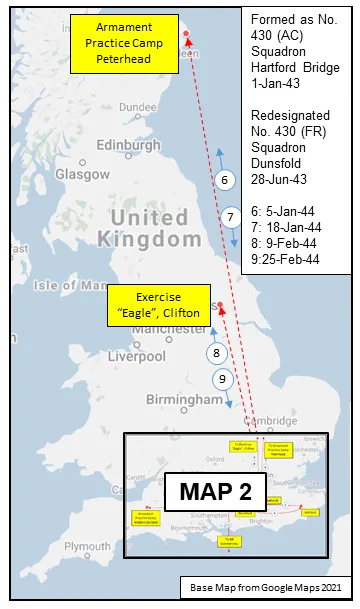 MAP 1: 430 Squadron Movements in UK 1943-44 (right-click on image to display enlarged in new tab) | 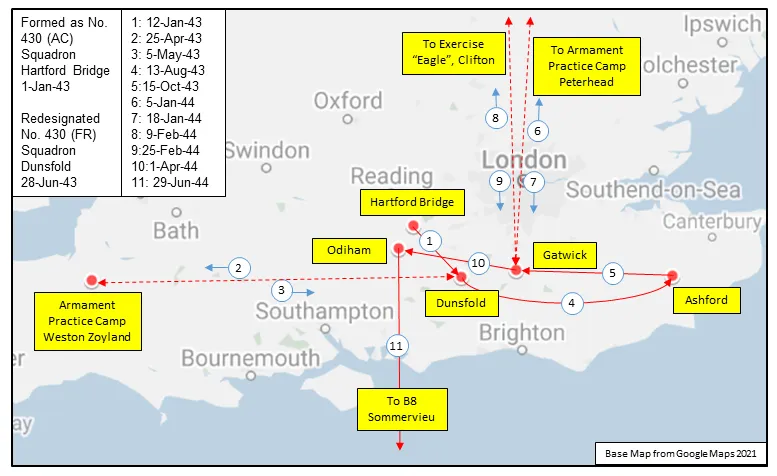 MAP 2: 430 Squadron Movements in Southern England 1943-44 (detail of Map 1) |
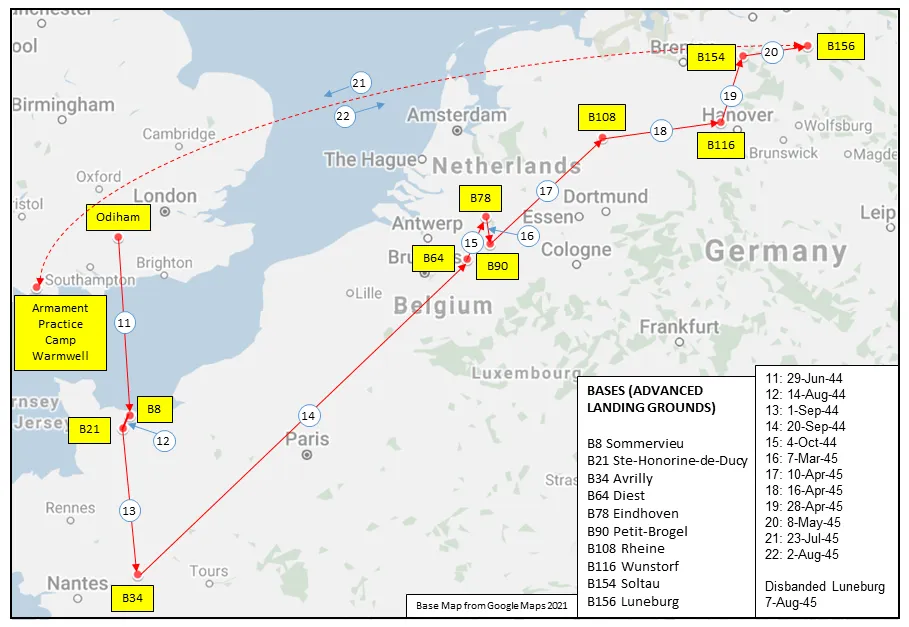
430 Squadron History Summary 1943-45
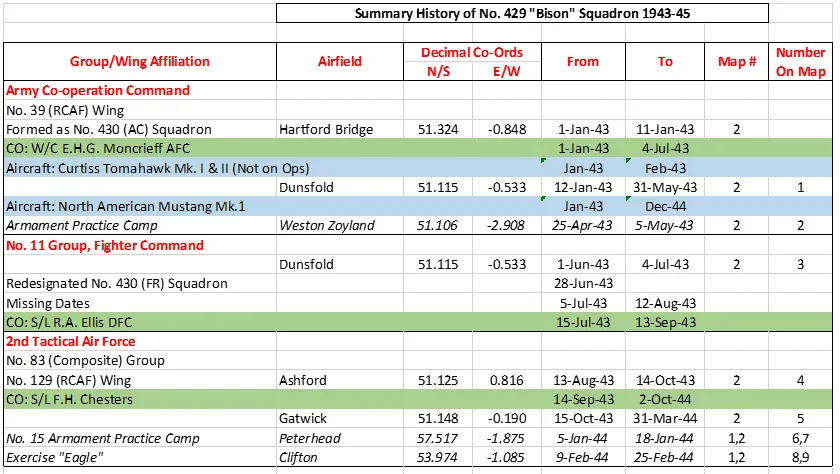
430 Squadron History Summary 1943-45 Page 2
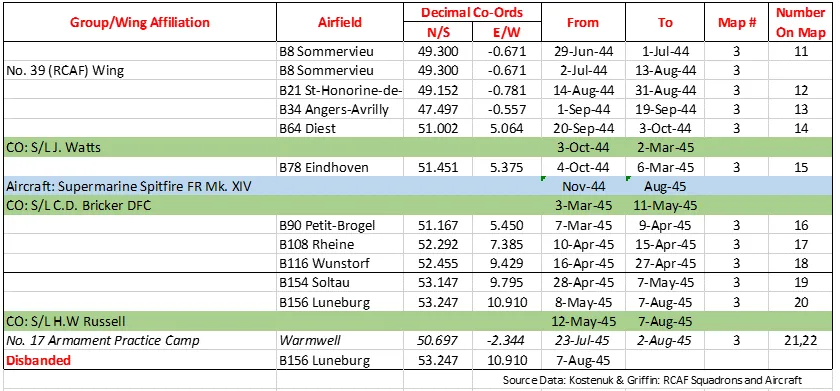
History of the Squadron Post-WWII (Aircraft: Sabre 2, 5, 6, Starfighter, Twin Huey, Kiowa, Griffon)
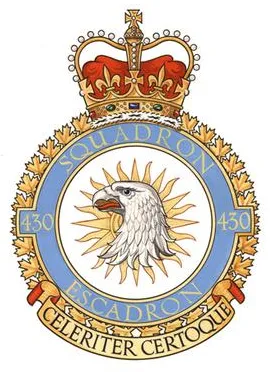
The squadron was re-formed as a Fighter unit at North Bay, Ontario on 1 November 1951. It was given the nickname Silver Falcon. With Sabre aircraft, the squadron joined No. 2 (Fighter) Wing at Grostenquin, France in September 1952. Selected as one of eight squadrons in No. 1 Air Division Europe to be re-equipped with CF-104 aircraft for a nuclear strike role, it was deactivated on 1 June 1963 and reactivated as Strike Attack on 30 September. When No. 2 Wing was disbanded on 24 February 1964, the squadron moved to No. 3 Wing at Zweibrucken, Germany. On 1 February 1968 the squadron was integrated into the Canadian Armed Forces. The squadron moved to 1 Wing Lahr, West Germany in February 1969 until it was disbanded in May 1970.
The unit reformed again in 1971 as a French-language Canadian Forces tactical helicopter squadron at Valcartier and known officially as 430e Escadron tactique d'hélicoptères. There it operated the Bell CH-136 Kiowa and the Bell CH-135 Twin Huey in support of 5 Canadian Mechanized Brigade Group. The unit transitioned to the CH-146 Griffon in 1994. 430 THS has participated in several international missions, in locations including Haiti, Bosnia-Herzegovina, Kosovo, Afghanistan, Iraq, and Mali.
 Choloy War Cemetery, Choloy, Meurthe-Et-Moselle, France
Choloy War Cemetery, Choloy, Meurthe-Et-Moselle, France Canadian Virtual War Memorial
Canadian Virtual War Memorial Harold A Skaarup Web Page
Harold A Skaarup Web Page